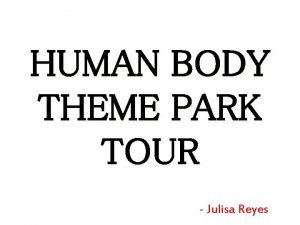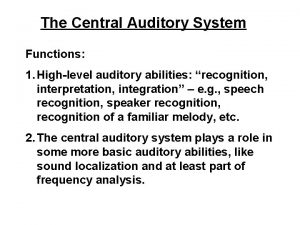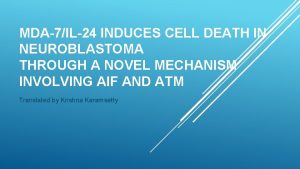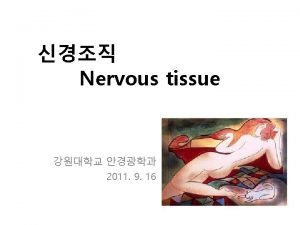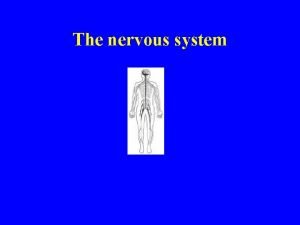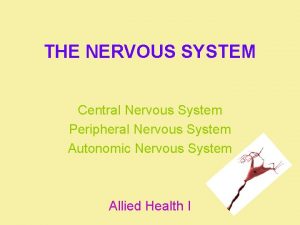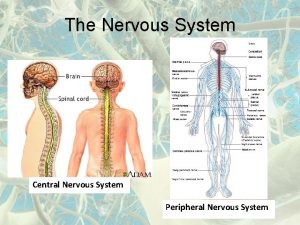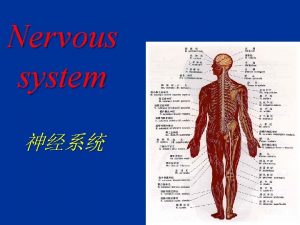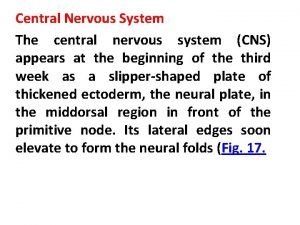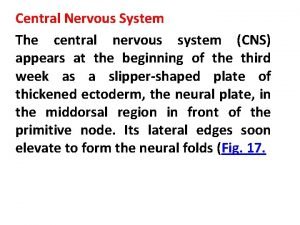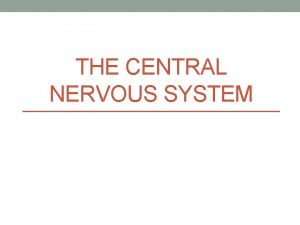The Central Nervous System The Central Nervous System


















- Slides: 18

The Central Nervous System

The Central Nervous System • The CNS coordinates the activities that go on within the body. It also processes and analyzes the information brought in by the PNS and the sensory organs. • The CNS is composed of: o The brain o The spinal cord.

The Brain • The brain is composed of nerve cells, (neurons). • There are 3 main parts of the brain: o The cerebrum o The cerebellum o The brain stem. • The brain is protected by the cranium, (skull), and the meninges, (membranes that envelope the brain. • The brain communicates with the rest of the body through a series of nerves, called cranial nerves.


The Cerebrum • The cerebrum is the largest part of the brain. • It controls voluntary movements, interprets the senses, is responsible for intelligence, and is the centre for emotions. • It is divided into two hemispheres: o The left hemisphere controls the right side of the body. o The right hemisphere controls the left side of the body. • The outer most part of the brain is called the cerebral cortex. It processes higher brain functions like reasoning and planning.

4 Lobes • The cerebrum is also divided into four lobes. Each lobe processes different things. • The frontal lobe: o Behaviour and emotion control, thinking, planning and reasoning, movement. • The temporal lobe: o Hearing, memory, language. • The parietal lobe: o Perception, arithmetic, spelling • The occipital lobe: o Vision

Cerebral Cortex

Brain Function Description Controls voluntary movements When we want to do a specific movement, like raising our hands or dancing, the part of the cerebrum associated with motor control sends a nerve impulse to our muscles, allowing this to happen. Interprets messages picked up by the sensory organs. When one of our sensory organs picks up a stimulus, nerve impulses travel to a specific part of the cerebrum. The specific region will analyze the information, identify it, and sometimes send a nerve impulse via the motor nerves to cause a reaction. Controls intelligence Problem-solving, reading, writing and speaking are intellectual activities. Different regions of the cerebrum are simultaneously responsible for each of these intelligence-activities.

Function Description Controls Emotion Managing emotions is a complex, and not well understood function of the brain. Like with intelligence, different regions simultaneously work to control emotion. Regulates physiological functions The hypothalamus, which lies below the cerebrum, is responsible for major functions of the body, including hunger, thirst, alertness and temperature regulation. It also controls the activity of the pituitary gland.


The Cerebellum • The cerebellum is associated with balance and movement. It coordinates movement based on various amount of information and stimulus from all around the body. • The cerebellum enables us to walk, run, speak, play sports, play instruments, etc.

The Brain Stem • The brain stem is attached to the spinal cord, the cerebrum and the cerebellum. • It processes all internal stimuli, (hunger, thirst, heartburn), and controls involuntary movements. o When you eat, the brain stem ensures proper digestive processes occur. o Signals glands to secrete like normal. o Etc.

Summary of the Brain Part Description Largest part of the brain. Cerebrum Divided into left and right hemispheres. Outer layer called the cerebral cortex. Role Complex analysis of stimuli from the PNS. Controls intelligence, emotions and physiological functions. Controls voluntary Divided into various lobes. movements. Cerebellum Located underneath the cerebrum. Brain Stem Located between the Processes internal stimuli. cerebrum and the cerebellum. Connected to Controls involuntary both. movements of the body. Connects the brain to the spinal cord. Controls balance and coordination.

The Spinal Cord • The spinal cord is the communication cable that runs through the body. It carries most of the nerve impulses between the body and the brain. • It also processes and conveys information related to reflexes. • Throughout the length of the spinal cord, one can find 31 pairs of nerves, called the spinal nerves. • The spinal cord is made of soft tissues, protected by meninges and the spinal column, or vertebrae.


… • The spinal cord is also the centre of the body that processes reflexes. • A reflex is a rapid and involuntary reaction to a stimulus. • For example: when a reflex occurs, the spinal cord intercepts the stimuli before it reaches the brain. The spinal cord causes and reaction. The brain will analyze the situation only after the reflex. • This is called a reflex arc – the path taken by a nerve impulse in a reflex.

… • Why do we have reflexes? • It is our body’s response system to an emergency, like if we touch something hot, or if a light is too bright.

Image Credits • http: //img. webmd. com/dtmcms/live/webmd/consumer_assets/sit e_images/media/medical/hw/h 9991474_001. jpg • http: //www. cancerresearchuk. org/prod_consump/groups/cr_co mmon/@cah/@gen/documents/image/cr_116645. jpg • http: //tonks. disted. camosun. bc. ca/courses/psyc 110/biopsyc/f 0411. jpg • http: //www. amfar. org/uploaded. Images/Articles/In_The_ Lab/BRAIN. jpg • https: //staff. rockwood. k 12. mo. us/baremorekeith/HAP/Document s/Central%20 Nervous%20 System/spinal%20 cord%20 cross%20 sectio n%20 with%20 answers. jpg • http: //2. bp. blogspot. com/p. KNLCVes. C 98/Ty. VV 77 ly. VDI/AAAAAQE/7 e. MQSPc. Z 6 HI/s 1600 /Screen+Shot+2012 -01 -29+at+7. 36. 42+PM. png
 Neuronal pool
Neuronal pool Nervous
Nervous Neuron processes
Neuron processes Central and peripheral nervous system
Central and peripheral nervous system Central nervous system amusement park
Central nervous system amusement park Diagram of central nervous system
Diagram of central nervous system Nervous system vocabulary
Nervous system vocabulary Nervous system of grasshopper
Nervous system of grasshopper Central auditory nervous system
Central auditory nervous system Electrical synapse vs chemical synapse
Electrical synapse vs chemical synapse Central nervous system for kids
Central nervous system for kids Central nervous sysytem
Central nervous sysytem Nervous system and digestive system
Nervous system and digestive system Endocrine system and nervous system
Endocrine system and nervous system Amino acid-based hormones
Amino acid-based hormones Adh function
Adh function Chemical messengers of the nervous system
Chemical messengers of the nervous system Nematódeos
Nematódeos The nervous system is made up of
The nervous system is made up of




